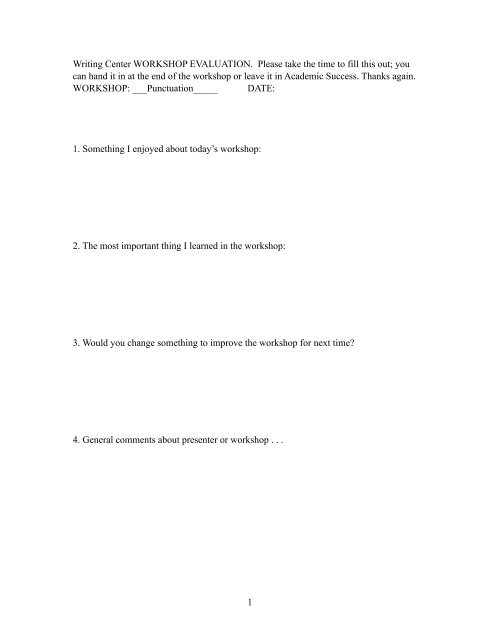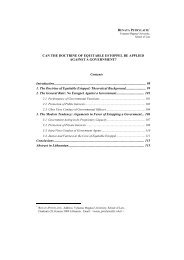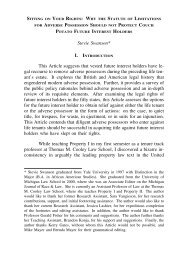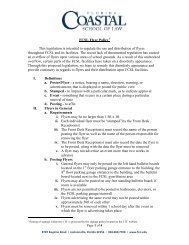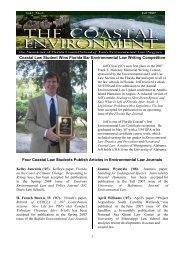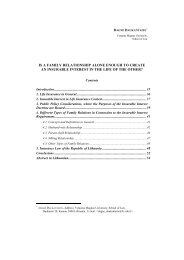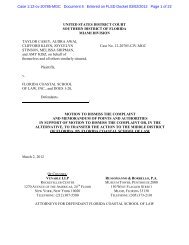1 Writing Center WORKSHOP EVALUATION. Please take the time to ...
1 Writing Center WORKSHOP EVALUATION. Please take the time to ...
1 Writing Center WORKSHOP EVALUATION. Please take the time to ...
Create successful ePaper yourself
Turn your PDF publications into a flip-book with our unique Google optimized e-Paper software.
<strong>Writing</strong> <strong>Center</strong> <strong>WORKSHOP</strong> <strong>EVALUATION</strong>. <strong>Please</strong> <strong>take</strong> <strong>the</strong> <strong>time</strong> <strong>to</strong> fill this out; you<br />
can hand it in at <strong>the</strong> end of <strong>the</strong> workshop or leave it in Academic Success. Thanks again.<br />
<strong>WORKSHOP</strong>: ___Punctuation_____ DATE:<br />
1. Something I enjoyed about <strong>to</strong>day’s workshop:<br />
2. The most important thing I learned in <strong>the</strong> workshop:<br />
3. Would you change something <strong>to</strong> improve <strong>the</strong> workshop for next <strong>time</strong>?<br />
4. General comments about presenter or workshop . . .<br />
1
PUNCTUATION <strong>WORKSHOP</strong><br />
COMMA<br />
SEMI-COLON<br />
COLON<br />
APOSTROPHES (for personal review)<br />
PUNCTUATION WITHIN QUOTATIONS (for personal review)<br />
EM DASHES (for personal review)<br />
The Costly Comma<br />
2
Punctuation Workshop<br />
COMMAS, SEMICOLONS, COLONS & APOSTROPHES.<br />
I. Commas<br />
RULE 1: USE COMMAS TO SET OFF NONRESTRICTIVE ELEMENTS IN A<br />
SENTENCE.<br />
A nonrestrictive phrase or clause is one that, if removed from <strong>the</strong> sentence, will not<br />
change its meaning. It gives additional description or information that is incidental <strong>to</strong> <strong>the</strong><br />
central meaning of <strong>the</strong> sentence.<br />
In <strong>the</strong> examples below, note that both sentences are grammatically correct, but that <strong>the</strong><br />
use of commas changes <strong>the</strong>ir meaning.<br />
Examples<br />
Non restrictive: The meeting, which starts at 10 a.m., is about <strong>the</strong> Mat<strong>the</strong>ws case. (The<br />
<strong>time</strong> is incidental <strong>to</strong> <strong>the</strong> meaning. The writer has already identified <strong>the</strong> meeting referred<br />
<strong>to</strong>.)<br />
Restrictive: The meeting that starts at 10 a.m. is about <strong>the</strong> Mat<strong>the</strong>ws case. (In this<br />
sentence, <strong>the</strong> meeting is one of several and is identified or restricted by <strong>the</strong> <strong>time</strong>. So “that<br />
starts at 10 a.m.” is a restrictive phrase.)<br />
Non restrictive: At<strong>to</strong>rneys, who intentionally prolong litigation for personal gain, misuse<br />
<strong>the</strong> legal system. (This sentence says that all at<strong>to</strong>rneys misuse <strong>the</strong> legal system.)<br />
Restrictive: At<strong>to</strong>rneys who intentionally prolong litigation for personal gain misuse <strong>the</strong><br />
legal system. (The phrase “who intentionally prolong litigation for personal gain”<br />
restricts <strong>the</strong> class of at<strong>to</strong>rneys who misuse <strong>the</strong> legal system.)<br />
A word or phrase next <strong>to</strong> a noun that fur<strong>the</strong>r describes it is frequently non-restrictive.<br />
Non restrictive: Luke Skywalker, a well respected Jedi Knight, played a vital role in<br />
destroying <strong>the</strong> Death Star. (“Luke Skywalker” is not fur<strong>the</strong>r restricted by <strong>the</strong> phrase “a<br />
well respected Jedi Knight.”<br />
But such descriptive phrases may be restrictive when it provides specific identification.<br />
3
Restrictive: The Jedi who uses <strong>the</strong> purple light saber nearly killed <strong>the</strong> Emperor. (“With<br />
<strong>the</strong> purple light saber” specifically identifies – restricts – <strong>the</strong> Jedi, so we can know which<br />
Jedi nearly killed <strong>the</strong> Emperor.)<br />
Some<strong>time</strong>s <strong>the</strong> punctuation may depend on <strong>the</strong> situation. If I have only one sister, <strong>the</strong>n:<br />
Non restrictive: My sister, Rachel, is a lawyer. (Because I have only one sister,<br />
“Rachel” is not necessary <strong>to</strong> identify “my sister.” Compare with “My sister is a lawyer.”)<br />
But if I have two sisters, Rachel and Emily, <strong>the</strong>n “My sister is a lawyer.” does not give<br />
enough information <strong>to</strong> identify which sister is a lawyer.<br />
Restrictive: My sister Rachel is a lawyer. (Because “Rachel” is necessary <strong>to</strong> identify<br />
which sister we are referring <strong>to</strong>.)<br />
Rule 1: Restrictive and Non Restrictive Exercises<br />
In <strong>the</strong> following sentences, identify <strong>the</strong> restrictive or non restrictive elements and<br />
punctuate according <strong>to</strong> <strong>the</strong> information in paren<strong>the</strong>ses.<br />
1. The book that/which is on <strong>the</strong> bureau is mine. (There is more than one book)<br />
2. The getaway car that/which was pock-marked with rust was parked in my<br />
driveway. (There is only one getaway car)<br />
3. The girl who is picking flowers is in love. (There is more than one girl)<br />
4. The detective who smelled strongly of <strong>to</strong>bacco <strong>to</strong>ok down my statement. (There is<br />
only one detective)<br />
5. A box of legal documents dating from <strong>the</strong> 19 th Century had been s<strong>to</strong>red in <strong>the</strong><br />
courthouse attic for generations. (There is more than one box of legal documents<br />
s<strong>to</strong>red in <strong>the</strong> attic.)<br />
6. The exhibit which/that proves my argument is very complicated. (There is only<br />
one exhibit)<br />
RULE 2: USE COMMAS AFTER AN INTRODUCTORY CLAUSE OR PHRASE.<br />
4
Introduc<strong>to</strong>ry matter may be a single word of transition , a phrase , or a dependent clause .<br />
A) After introduc<strong>to</strong>ry clauses which tell when, where, how, why, or under what<br />
conditions.<br />
• When <strong>the</strong> student is ready, <strong>the</strong> teacher will appear.<br />
• Next door, <strong>the</strong> noise was growing louder.<br />
• Almost inaudibly, <strong>the</strong> witness described <strong>the</strong> crime scene.<br />
• Because he couldn’t tell <strong>the</strong> truth, he refused <strong>to</strong> testify.<br />
• Since <strong>the</strong> company refused <strong>to</strong> settle, we instructed our at<strong>to</strong>rneys <strong>to</strong> sue.<br />
B) After participial phrases which describe <strong>the</strong> noun or pronoun immediately<br />
following <strong>the</strong>m.<br />
• Using wiretap technology, <strong>the</strong> detectives acquired enough information <strong>to</strong><br />
make <strong>the</strong> arrest.<br />
C) After introduc<strong>to</strong>ry phrases (which tell us when, where, why, how, or under what conditions something<br />
happens).<br />
• “If thought corrupts language, language can also corrupt thought.” –<br />
George Orwell<br />
D) After verbals (verb forms used as ano<strong>the</strong>r part of speech).<br />
• Wishing <strong>to</strong> clarify, <strong>the</strong> witness repeated himself.<br />
E) Exception: Use no comma if <strong>the</strong>se phrases come at <strong>the</strong> end of a sentence.<br />
• Because it was a cold night, we <strong>to</strong>ok refuge before a roaring fire, versus<br />
We <strong>to</strong>ok refuge before a roaring fire because it was a cold night.<br />
F) Exception:<br />
In short introduc<strong>to</strong>ry phrases, if understanding is not compromised, <strong>the</strong><br />
comma may be omitted;<br />
If <strong>the</strong> subject of <strong>the</strong> first verb is <strong>the</strong> subject of <strong>the</strong> second, no comma is<br />
necessary.<br />
1. In no <strong>time</strong> we reached <strong>the</strong> <strong>to</strong>p.<br />
2. Alisa brought <strong>the</strong> injured bird home and fashioned a splint out of Popsicle<br />
sticks for its wing.<br />
Rule 2: Introduc<strong>to</strong>ry phrase exercises: place commas if needed.<br />
5
1. When <strong>the</strong> runaway race car crashed <strong>the</strong> gas tank exploded.<br />
2. As <strong>the</strong> concert began we heard a tremendous explosion.<br />
3. During an extended recess in <strong>the</strong> beautiful garden <strong>the</strong> parties reached an<br />
agreement.<br />
4. Whenever you want we can complete <strong>the</strong> forms.<br />
5. Juan walked <strong>to</strong> <strong>the</strong> witness stand with casual elegance.<br />
RULE 3: USE A COMMA BEFORE A COORDINATING CONJUNCTION<br />
JOINING TWO INDEPENDENT CLAUSES.<br />
Coordinating conjunctions are For, And, Nor, But, Or, Yet, So (remember FANBOYS).<br />
Examples:<br />
The defendant wept during <strong>the</strong> cross-examination, but <strong>the</strong> jury remained impassive.<br />
The prosecu<strong>to</strong>r spoke about <strong>the</strong> defendant’s motive, and <strong>the</strong> jury listened carefully.<br />
The detainee had no alibi, so police held her for fur<strong>the</strong>r questioning.<br />
Exception: If <strong>the</strong> sentence is short and <strong>the</strong> meaning is clear without punctuation, omit <strong>the</strong><br />
comma if you wish.<br />
It rained and it snowed<br />
The boy cried and his mo<strong>the</strong>r glared at me.<br />
Exception: The subject of both clauses is <strong>the</strong> same.<br />
The boy cried hard and he was unable <strong>to</strong> speak.<br />
Rule 3: Coordinating Conjunction exercise.<br />
Remember FANBOYS and place commas where needed.<br />
1. Many serial killers have appeared since Jack <strong>the</strong> Ripper but few have been as<br />
famous or as feared as he was.<br />
2. Jane played <strong>the</strong> piano and Michael danced.<br />
3. Are we really interested in helping <strong>the</strong> children or are we just trying <strong>to</strong> protect our<br />
good names?<br />
4. The jury has not yet reached a verdict nor does it look like it will any<strong>time</strong> soon.<br />
5. I washed my hands and put nice smelling lotion on <strong>the</strong>m.<br />
6
RULE 4: USE A COMMA TO SEPARATE MORE THAN TWO ITEMS IN A SERIES;<br />
INCLUDE A COMMA BEFORE THE LAST “AND,” UNLESS TOLD TO DO<br />
DIFFERENTLY BY YOUR PROFESSOR. THE ITEMS MAY BE SINGLE WORDS,<br />
CLAUSES, VERB PHRASES, ETC.<br />
Examples:<br />
The case went on so long that it drained <strong>the</strong>m economically, ruined <strong>the</strong>ir relationship,<br />
and caused <strong>the</strong>m both serious health problems that required hospitalization.<br />
Before accepting <strong>the</strong> case, <strong>the</strong> at<strong>to</strong>rney consulted with her associates, investigated <strong>the</strong><br />
client’s financial situation, and interviewed <strong>the</strong> client’s spouse.<br />
NB1: Notice that in all <strong>the</strong> above examples <strong>the</strong> items in <strong>the</strong> series are parallel, that is<br />
<strong>to</strong> say <strong>the</strong>y mirror each o<strong>the</strong>r in grammatical structure.<br />
NB2: Be sure <strong>to</strong> be precise when deciding about comma use. In <strong>the</strong> following<br />
example, what portion of <strong>the</strong> property do each of <strong>the</strong> people mentioned receive?<br />
Ms. Corsini wants her property divided equally among <strong>the</strong> following relatives:<br />
Michael Corsini, Glenda Corsini, Joanna Mitchem, Louis Mitchem, Donna Mitchem<br />
and Donald Mitchem.<br />
Exception: Some adjective-noun combinations function as one word; don’t use a<br />
comma between <strong>the</strong>m. For example:<br />
1. The divorcing couple fought over who would get <strong>the</strong> antique pine writing desk.<br />
Rule 4: Comma use in series exercises. Place commas where appropriate<br />
1. My favorite sandwich is peanut butter and jelly.<br />
2. The lawyer who communicates well with clients who files <strong>time</strong>ly motions and who<br />
maintains good financial records reduces her risk of malpractice.<br />
3. I like long-stemmed fine-crystal wine glasses.<br />
4. As a child I was <strong>to</strong>ld <strong>to</strong> say “yes m‘am and yes sir” “thank you and please” and<br />
”hello and goodbye” <strong>to</strong> all adults.<br />
RULE 5A: USE A COMMA TO PREVENT POSSIBLE MISREADING.<br />
This is a question of common sense. Examples:<br />
8
1. While we were eating, <strong>the</strong> dogs escaped<br />
2. Of <strong>the</strong> twenty, two witnesses are willing <strong>to</strong> testify.<br />
RULE 5B: USE A COMMA TO ENCLOSE PARENTHETICAL (ADDED OR<br />
INTERJECTED INFORMATION) PHRASES. See example:<br />
1. His report, written under duress, was worthless.<br />
RULE 5c: USE A COMMA BETWEEN PARTS OF GEOGRAPHICAL NAMES,<br />
ADDRESSES, AND DATES. See below:<br />
1. The climate in Leadville, Colorado, is invigorating.<br />
2. No. 10 Downing Street, London, England, is <strong>the</strong> dwelling of <strong>the</strong> British Prime<br />
Minister.<br />
3. On Wednesday, July 13, 1990, he left on vacation.<br />
RULE 5D: USE A COMMA TO SET OFF CONTRASTING ELEMENTS. See<br />
below:<br />
1.I said I was happy about <strong>the</strong> verdict, not ecstatic.<br />
RULE 5E: USE A COMMA TO SET OFF AN APPOSOTIVE (A NOUN THAT<br />
DIRECTLY FOLLOWS ANOTHER NOUN AND FURTHER DESCRIBES IT). See<br />
below:<br />
1.Marion Howes, president of our company, has a contract <strong>to</strong> die for.<br />
2.An FCSL student, Jesus Garcia, won <strong>the</strong> award.<br />
RULE 5F: USE A COMMA TO SET OFF WORDS OF DIRECT ADDRESS, MILD<br />
INTERJECTIONS, YES AND NO, INTERROGATIVE TAGS. See below:<br />
1. Alas, <strong>the</strong> world is indeed <strong>to</strong>o much with us.<br />
2. Yes, <strong>the</strong> problem persists.<br />
3. It seems clear, doesn’t it?<br />
4.May I ask for an interpreter, Judge Golden?<br />
Rule 5: Exercises in use of comma <strong>to</strong> prevent misreadings; <strong>to</strong> set off<br />
paren<strong>the</strong>tical phrases, contrasting elements, and appositives; in<br />
geographical names, addresses, and dates; in direct address.<br />
Place commas correctly in <strong>the</strong> following.<br />
1. If you want a court interpreter can help with <strong>the</strong> cross-examination.<br />
2.While we were happy with <strong>the</strong> results <strong>the</strong> judge wasn’t.<br />
3. The jury focused on <strong>the</strong> defendant’s guilt ra<strong>the</strong>r than on his repentance.<br />
9
4. The only reason I am here if you want <strong>to</strong> know <strong>the</strong> truth is because I have <strong>to</strong> be.<br />
5. You will won’t you?<br />
6. I lived in Hermosa Beach California for six years.<br />
7. In Manhattan on September 11 2001 a tragedy occurred which <strong>the</strong> world will<br />
never forget.<br />
II. SEMICOLONS<br />
Use <strong>the</strong> semicolon <strong>to</strong> connect major sentence elements of equal grammatical rank. Be<br />
careful not <strong>to</strong> overuse semicolon<br />
Put semicolons outside quotation marks unless <strong>the</strong>y form part of <strong>the</strong> quote<br />
RULE 1: USE A SEMICOLON BETWEEN CLOSELY RELATED INDEPENDENT<br />
CLAUSES NOT JOINED WITH A COORDINATING CONJUNCTION (FANBOYS).<br />
Instead of writing<br />
Main Clause, and Main Clause<br />
You can write<br />
Main clause; main clause<br />
Clause closely relate <strong>to</strong> each o<strong>the</strong>r<br />
Examples:<br />
1. Injustice is relatively easy <strong>to</strong> bear; what stings is justice. – H.L. Mencken<br />
2. When I was a boy I was <strong>to</strong>ld that anyone could become president; I’m beginning<br />
<strong>to</strong> believe it. – Clarence Darrow<br />
RULE 2: USE A SEMICOLON BETWEEN INDEPENDENT CLAUSES LINKED WITH A<br />
TRANSITIONAL EXPRESSION. USUALLY, THESE ARE PRECEDED BY A<br />
SEMICOLON AND FOLLOWED BY A COMMA. (See table below for transitional<br />
expressions).<br />
Examples:<br />
1. Many corals grow very gradually; in fact, <strong>the</strong> creation of a coral reef can <strong>take</strong><br />
centuries.<br />
2. Most singers gain fame through hard work and dedication; Evita, however, found<br />
o<strong>the</strong>r means.<br />
10
TRANSITIONAL EXPRESSIONS<br />
Conjunctive adverbs Transitional Phrases<br />
Accordingly Fur<strong>the</strong>rmore After all Even so<br />
Moreover Subsequently In fact As a matter of fact<br />
Also Hence For example In o<strong>the</strong>r words<br />
Never<strong>the</strong>less Then As a result For instance<br />
Anyway However In <strong>the</strong> first place At any rate<br />
Next Therefore In addition On <strong>the</strong> contrary<br />
Besides Incidentally At <strong>the</strong> same <strong>time</strong> In conclusion<br />
None<strong>the</strong>less Thus On <strong>the</strong> o<strong>the</strong>r hand<br />
Certainly Indeed<br />
O<strong>the</strong>rwise Consequently<br />
Instead Similarly<br />
Conversely Likewise<br />
Finally Still<br />
meanwhile<br />
RULE 3: USE A SEMICOLON BETWEEN ITEMS IN A SERIES CONTAINING<br />
INTERNAL PUNCTUATION. SEE EXAMPLE BELOW.<br />
o The following legal educa<strong>to</strong>rs joined interdisciplinary committee: Jeanette<br />
Dawson, dean of Valley Law School; Richard Riley, dean of Balfour Law School;<br />
and Gordon Grant, dean of Packard Law School.<br />
RULE 4: USE SEMICOLONS BETWEEN INDEPENDENT CLAUSES IF THERE ARE<br />
MANY COMMAS WITHIN THE CLAUSES. SEE EXAMPLE BELOW.<br />
o The Barrister, a new legal journal, and one of <strong>the</strong> most original <strong>to</strong> appear in <strong>the</strong><br />
past decade, advertised for an edi<strong>to</strong>rial car<strong>to</strong>onist; and <strong>the</strong> applicants who<br />
responded, interestingly enough, were at<strong>to</strong>rneys.<br />
Rules 1, 2, 3, & 4: Semicolon Exercises. Place semicolons where needed<br />
(perhaps by replacing commas).<br />
1. Thorndike’s permission <strong>to</strong> use his land was an oral license <strong>the</strong>refore he has <strong>the</strong><br />
right <strong>to</strong> evoke <strong>the</strong> license <strong>to</strong> use his property.<br />
2. The child’s fa<strong>the</strong>r <strong>to</strong>ok her from her home by force and against <strong>the</strong> will of her<br />
mo<strong>the</strong>r consequently <strong>the</strong> court charged <strong>the</strong> defendant with kidnapping.<br />
11
3. The first two elements are satisfied however <strong>the</strong> third element hostility is not<br />
satisfied.<br />
4. Permission is a revocable act it does not ripen in<strong>to</strong> a prescriptive right unless <strong>the</strong><br />
user’s acts evidence a positive assertion of a right <strong>to</strong> use.<br />
5. The reasonableness test includes several fac<strong>to</strong>rs: <strong>the</strong> location of <strong>the</strong> business, <strong>the</strong><br />
degree of interference with ano<strong>the</strong>r business, and <strong>the</strong> test of sensibilities, that is,<br />
whe<strong>the</strong>r a person of ordinary sensibilities would be offended.<br />
6. In order <strong>to</strong> expedite <strong>the</strong> insurance claim, we were requested <strong>to</strong> make a list of all<br />
items especially furniture and appliances that had been destroyed in <strong>the</strong> fire<br />
provide copies of all pertinent insurance papers and property deeds and get<br />
notarized statements, as complete as possible from all witnesses.<br />
III. COLONS<br />
The colon primarily <strong>to</strong> call attention <strong>to</strong> <strong>the</strong> words that follow it; in addition, <strong>the</strong> colon<br />
has some conventional uses.<br />
Put colons outside quotation marks unless <strong>the</strong>y form part of <strong>the</strong> quote.<br />
RULE 1: USE A COLON AFTER AN INDEPENDENT CLAUSE TO DIRECT ATTENTION<br />
TO A LIST, AN APPOSITIVE, OR A QUOTATION. SEE EXAMPLES BELOW.<br />
A list<br />
o She gave away everything she owned: her clo<strong>the</strong>s, her books, her furniture, and<br />
her art work.<br />
An appositive (which defines or elaborates what comes before it)<br />
o My roommate is guilty of two of <strong>the</strong> seven deadly sins: glut<strong>to</strong>ny and sloth.<br />
A quotation, 1 especially long quotations<br />
o Consider <strong>the</strong> words of John F. Kennedy: “Ask not what your country can do for<br />
you; ask what you can do for your country.”<br />
RULE 2: USE A COLON BETWEEN INDEPENDENT CLAUSES IF THE SECOND<br />
SUMMARIZES OR EXPLAINS THE FIRST.<br />
1 A quotation can also be introduced by a comma or no punctuation at all, whichever is appropriate in<br />
context. For example, a comma is used after expressions such as he said or she remarked. But: The report<br />
stated that she escaped “by squeezing through a tiny window.”<br />
12
o A referee must possess one basic qualification: she must be fair.<br />
RULE 3: USE A COLON AFTER THE FOLLOWING, AND AS FOLLOWS.<br />
o For <strong>the</strong> camping trip we were <strong>to</strong>ld <strong>to</strong> bring <strong>the</strong> following: a sleeping blanket,<br />
insect repellent, and a knife.<br />
RULE 4: DO NOT USE A COLON<br />
•after such as, include/including, for example, namely, specifically<br />
•between a verb and its object or complement (example below)<br />
o Some important vitamins found in vegetables are vitamin A, thiamine,<br />
niacin, and vitamin C.<br />
•between a preposition and its object (see below)<br />
o Our system of government consists of a judiciary, a legislative, and an<br />
executive branch.<br />
Rules 1, 2, 3, & 4: Exercises on use of colon.<br />
Place or remove colon where necessary.<br />
1. The travel package includes: a round-trip ticket <strong>to</strong> A<strong>the</strong>ns, a cruise through <strong>the</strong><br />
Cyclades, and all hotel accommodations.<br />
2. The jury found for <strong>the</strong> defendant for one reason There was an evident lack of<br />
evidence.<br />
3. Carl Sandburg once asked three important questions “Who paid for my freedom?<br />
What was <strong>the</strong> price? And am I somehow beholden?”<br />
4. There was only one person who could answer for <strong>the</strong> boy’s whereabouts <strong>the</strong> boys<br />
guardian.<br />
5. The doc<strong>to</strong>r <strong>to</strong>ld me <strong>to</strong> avoid all sweets, such as: cookies, cakes, and candy.<br />
6. He arrived at <strong>the</strong> shelter with: his entire family, his two dogs, his DVD player, and<br />
an ice chest full of Snickers.<br />
I. APOSTROPHES<br />
Apostrophes show possession, denote omitted words or letters, and (generally) form <strong>the</strong><br />
plural of letters, figures, signs, or symbols.<br />
13
A. Rule: Use –‘s <strong>to</strong> indicate that a singular noun is possessive.<br />
Example: It is all in a day’s work.<br />
B. Rule: If a noun is singular and ends in -s, add -‘s <strong>to</strong> form <strong>the</strong> possessive.<br />
Example: Lois’s main complaint about her life is that it just goes on and on.<br />
C. Rule: Do not add an additional apostrophe “s” if three sibilant sounds will result<br />
and/or dis<strong>to</strong>rt <strong>the</strong> word.<br />
Example: Some are saying that Stephanie Spears’ newest song is plagiarized.<br />
D. Rule: There should generally be no apostrophe after classical names if that would<br />
produce awkwardness.<br />
Example: He read every one of Sophocles’ plays for <strong>the</strong> exam only <strong>to</strong> discover that<br />
<strong>the</strong> exam covered Aris<strong>to</strong>phanes’ plays instead.<br />
E. Rule: If <strong>the</strong> plural of <strong>the</strong> noun ends in -s or -es just add <strong>the</strong> apostrophe (s’).<br />
Example: The briefcases’ locks didn’t hold, which proved <strong>to</strong> be very embarrassing<br />
because <strong>the</strong> briefcases were full of a white powdery substance.<br />
F. Rule Individual vs. Joint Possession: To show individual possession, use -‘s or -s’<br />
with all nouns; <strong>to</strong> show joint possession, use -‘s or -s’ with <strong>the</strong> last noun.<br />
Example 1 (joint possession): Have you seen Joyce and Gene’s new quintuplets?<br />
Example 2 (individual): John’s and Marie’s expectations of marriage couldn’t have<br />
been more different.<br />
G. Rule for Possession in Compound Nouns: If a noun is compound use -‘s or<br />
-s’ with <strong>the</strong> last element.<br />
Example 1: My sister-in-law’s main interest is sailing.<br />
Example 2: My Jack-in-<strong>the</strong>-pulpits’ leaves are turning yellow.<br />
14
H. Rule: Use -‘s <strong>to</strong> indicate that an indefinite pronoun is possessive.<br />
Example 1: Someone’s cell phone is ringing.<br />
Example 2: No one’s paper has been graded yet.<br />
Example 3: We do our best <strong>to</strong> see that each’s needs are met.<br />
I. Rule: Use an Apostrophe <strong>to</strong> indicate <strong>the</strong> Omission of Letters in Contractions and<br />
<strong>the</strong> Omission of Numbers.<br />
Example: It’s a shame that Madonna can’t be a part of <strong>the</strong> ’07 Tour for World<br />
Peace.<br />
J. Rule: Its, when possessive, never <strong>take</strong>s <strong>the</strong> apostrophe<br />
Example: The dog bit its master<br />
.<br />
K. Rule: The possessive form of who is whose; possessive pronouns (mine, yours,<br />
etc.) do not <strong>take</strong> an apostrophe.<br />
Example: Whose is this anyway, yours, mine, his, hers, or <strong>the</strong>irs?<br />
L. Rule: Use ‘s <strong>to</strong> indicate <strong>the</strong> plural of letters, single-digit numbers, symbols, words<br />
used as words, and some abbreviations (esp. lower case ones & punctuated ones).<br />
Ex: Mind your p’s and q’s.<br />
Ex: How many O’s are <strong>the</strong>re in a million? (Better: How many zeros. . .)<br />
Ex: What kind of mpg’s does this model get?<br />
Ex: How many J.D.’s were awarded?<br />
M. Rule: With capitalized abbreviations, multiple-digit numbers, and dates, <strong>the</strong> preferred<br />
plural is a simple –s.<br />
Ex: You will escort <strong>the</strong> VIPs <strong>to</strong> <strong>the</strong> head table.<br />
Ex: The new at<strong>to</strong>rney general cut his legal teeth as a Detroit prosecu<strong>to</strong>r in<br />
<strong>the</strong> ‘80s.<br />
Ex: Lows <strong>to</strong>night will be in <strong>the</strong> upper 30s.<br />
Avoid confusion. Compare: There are <strong>to</strong>o many Is in this word, <strong>to</strong> There are <strong>to</strong>o many<br />
I’s in this word. Or: The twenty multiple choice questions had twelve As in <strong>the</strong><br />
answers, as opposed <strong>to</strong> twelve A’s.<br />
And now: Make <strong>the</strong> name Aris<strong>to</strong>phanes plural_________, <strong>the</strong>n possessive,<br />
_____________and pronounce all <strong>the</strong> s’s (or is it “esses”?)<br />
This brings us <strong>to</strong> a convention which states we should avoid three or more es sounds.<br />
Also, in forming <strong>the</strong> possessive of foreign words <strong>the</strong> s after <strong>the</strong> apostrophe is usually<br />
omitted.<br />
15
How’s life? Mine or yours?<br />
Exercises: Put apostrophes where needed or correct <strong>the</strong> apostrophe use:<br />
1. My bro<strong>the</strong>rs wives are sisters.<br />
2. Marias and Eduardos claims both dealt with discrimination.<br />
3. Who’s brief is that?<br />
4. Mary and Jane’s children have two mo<strong>the</strong>rs.<br />
5. If your dog isnt eating it’s food, thats your problem.<br />
6. In <strong>the</strong> Basque language <strong>the</strong>re are no Vs, Cs, Qs, Ws, Ys, or Js.<br />
7. Siddhartha sat by <strong>the</strong> river and listened <strong>to</strong> its many voices.<br />
8. My sister’s-in-law husband filed for divorce.<br />
9. Dont look at each o<strong>the</strong>rs papers.<br />
10. Joe’s Sandwich Shop in Pittsburgh wont serve anyone who doesn’t speak English.<br />
Punctuation within quotation marks.<br />
Rule 1: Commas and periods are always inside <strong>the</strong> quotation marks.<br />
Example: “I don’t know,” John replied<br />
Example: To grant <strong>the</strong> defendant ano<strong>the</strong>r advantage would make <strong>the</strong> prosecu<strong>to</strong>r’s task<br />
“almost insurmountable.”<br />
Rule 2: Colons and semicolons go outside <strong>the</strong> quotation marks, even if <strong>the</strong><br />
quoted material happens <strong>to</strong> have a semicolon or colon in that position.<br />
16
Example: In order <strong>to</strong> formulate precise factual issues, a pleader had <strong>to</strong> state “facts,” not<br />
“conclusions”; and in order that <strong>the</strong> issues be material according <strong>to</strong> <strong>the</strong> substantive law,<br />
<strong>the</strong> stating of “evidence” was condemned.<br />
Example: “The validity of <strong>the</strong> reporters’ claim of a First Amendment privilege not <strong>to</strong><br />
disclose sources of information was decided on <strong>the</strong> results of two inquiries”: (1) were<br />
fears of sources drying up justified; and, if so, (2) does that loss outweigh <strong>the</strong> benefits of<br />
<strong>the</strong> testimony?<br />
Rule 3: Question marks and exclamation marks go inside <strong>the</strong> quotation<br />
marks only when <strong>the</strong>y are part of <strong>the</strong> quoted matter.<br />
Example: Does <strong>the</strong> parol-evidence rule play a similar role in excluding evidence of prior<br />
negotiations <strong>to</strong> interpret contract language that is “clear on its face”?<br />
Example: The court session opened with <strong>the</strong> traditional cry, “Oyez! Oyez! Oyez!”<br />
Exercises for punctuation with quotation marks. Punctuate as needed:<br />
Hamlet’s words “To be or not <strong>to</strong> be, that is <strong>the</strong> question” have been<br />
asked un<strong>to</strong>ld numbers of <strong>time</strong>s.<br />
<br />
What did <strong>the</strong> judge mean when he said “The plaintiff is in serious hot<br />
water”<br />
<br />
The answer, <strong>to</strong> quote May, “is in your heart” as Becky says, however,<br />
“You won’t find it if you don’t look”<br />
<br />
“You did what” asked <strong>the</strong> parole officer indignantly.<br />
“I’m fed up with you” <strong>the</strong> at<strong>to</strong>rney exclaimed.<br />
17
Em Dashes ∗<br />
The em dash (also called a “long dash”) is a forceful and conspicuous punctuation mark.<br />
As wide as <strong>the</strong> typeface is tall, <strong>the</strong> em dash stands out on <strong>the</strong> page. It highlights what it<br />
ei<strong>the</strong>r contains (when used in pairs) or separates from <strong>the</strong> main sentence. The same matter<br />
inside paren<strong>the</strong>ses would be deemphasized. As a separa<strong>to</strong>r, <strong>the</strong> em dash often performs<br />
<strong>the</strong> pointing function of a colon, and <strong>the</strong> two marks are interchangeable in those<br />
situations. On a computer, type an em dash with a special code; on a typewriter, indicate<br />
it with two hyphens. In documents created on word processors, use a space before and<br />
after <strong>the</strong> em dash <strong>to</strong> prevent awkward line breaks – even though fine book typography<br />
omits <strong>the</strong> space. Although you may have once heard a stern warning against em dashes,<br />
<strong>the</strong>y’re an important part of <strong>the</strong> writer’s <strong>to</strong>olbox. Just look at any page of first-rate<br />
published prose, and you’re going <strong>to</strong> see one or more irreplaceable dashes.<br />
I. Use an em dash—or pair of em dashes as required by sentence structure—<strong>to</strong> give<br />
matter that is independent of <strong>the</strong> main sentence more emphasis than paren<strong>the</strong>ses<br />
would provide.<br />
a) Setting off words at beginning or end of sentence. Use an em dash <strong>to</strong> separate an<br />
element that is placed at <strong>the</strong> beginning or end of a sentence and expands on<br />
ano<strong>the</strong>r part of <strong>the</strong> sentence. In this construction <strong>the</strong> dash is similar in function <strong>to</strong><br />
a colon (at <strong>the</strong> beginning) or paren<strong>the</strong>ses (at <strong>the</strong> end), abut more emphatic.<br />
Example: Principle—that’s what’s at s<strong>take</strong> here.<br />
Example: The most common problem of extra-record evidence occurs when <strong>the</strong>re<br />
are ex parte contacts—communications outside <strong>the</strong> hearing and off <strong>the</strong> record<br />
from an interested party <strong>to</strong> a decision-making official.<br />
b) In mid-sentence. Use a pair of em dashes instead of paren<strong>the</strong>ses <strong>to</strong> set off<br />
paren<strong>the</strong>tical matter—even an independent sentence—inside <strong>the</strong> main sentence.<br />
While paren<strong>the</strong>ses minimize what <strong>the</strong>y enclose, em dashes emphasize it. Do not<br />
use a comma, semicolon, or colon before or after <strong>the</strong> em dashes, even if one<br />
would be necessary without <strong>the</strong> interrupting matter.<br />
Example: Because an assignment for <strong>the</strong> benefit of credi<strong>to</strong>rs places <strong>the</strong> deb<strong>to</strong>r’s<br />
property out of <strong>the</strong> reach of <strong>the</strong> credi<strong>to</strong>rs—legal title passes <strong>to</strong> <strong>the</strong> assignee—it<br />
might seem that credi<strong>to</strong>rs would be able <strong>to</strong> void <strong>the</strong> assignment under a<br />
fraudulent-conveyance statute. (The comma that would have been required where<br />
<strong>the</strong> first em dash appears is no longer necessary.)<br />
c) With appositive. Use a pair of em dashes instead of commas <strong>to</strong> separate an<br />
appositive phrase, for <strong>the</strong> purpose of ei<strong>the</strong>r (1) emphasizing it more or (2)<br />
clarifying a phrase that contains internal commas.<br />
∗ Taken from THE REDBOOK. A MANUAL ON LEGAL STYLE. Bryan A. Garner. 3 rd reprint 2004.<br />
18
Example: The prediction must come from “reference <strong>to</strong> a law of general<br />
application”—a state stature or <strong>the</strong> state constitution—that will deny <strong>the</strong><br />
defendant’s civil rights. (Emphasis)<br />
Example: Aid <strong>to</strong> any of <strong>the</strong> elements of <strong>the</strong> traditional learning process institution,<br />
teachers, or students—is an educational purpose. (Internal commas)<br />
II. Use an em dash—or multiple em dashes—in several conventions <strong>to</strong> indicate<br />
missing information.<br />
a) In a transcript. An em dash may be used instead of ellipsis dots in transcript of<br />
dialogue <strong>to</strong> indicate an interruption or abrupt change of thought.<br />
Example: Q. Did <strong>the</strong>re come a point that you decided you couldn’t <strong>take</strong> it any<br />
longer?<br />
A. I explained <strong>to</strong> him that I was and he wouldn’t —like I said, he<br />
wouldn’t approve anything.<br />
b) In dates. Use an em dash after <strong>the</strong> birth ear in a biographical reference <strong>to</strong> indicate<br />
that <strong>the</strong> person is still alive.<br />
Example: David Foster Wallace (1962—).<br />
c) Expunction. Use two em dashes with no space between <strong>the</strong>m <strong>to</strong> replace part of a<br />
word or name. This devise is most often used <strong>to</strong> elide all but <strong>the</strong> first letter of a<br />
word or a name, usually ei<strong>the</strong>r <strong>to</strong> expunge an obscenity or <strong>to</strong> preserve a person’s<br />
anonymity.<br />
Example: “How do I get this—thing <strong>to</strong> work?”<br />
Example: Mr. H—informed <strong>the</strong> police of <strong>the</strong> robbery plans.<br />
d) In citations. In legal citations, use two em dashes with no space between <strong>the</strong>m <strong>to</strong><br />
indicate reporter volume and page numbers that have not yet been determined. An<br />
underline may also be used for this purpose.<br />
Example: Roe v. Flores-Ortega, —U.S. —, 120 S. Ct. 1029, 145 L Ed.2d<br />
985 (2000). Two em dashes.)<br />
Example: Roe v. Flores-Ortega, __U.S. __, 120 S. Ct. 1029, 145 L Ed.2d<br />
985 (2000). (Underlines.)<br />
e) Same author. Use three em dashes with no spaces between <strong>the</strong>m <strong>to</strong> indicate <strong>the</strong><br />
repetition of an author’s name in an alphabetical bibliography.<br />
19
Ex.: Kilpatrick, James J. The New York Times Style Book for Writers and Ei<strong>to</strong>rs.<br />
Edited by Lewis Jordan. 3d ed. New York: McGraw-Hill 1962. –—, The Writer’s<br />
Art. Kansas City: Andrews, McMeel & Parker, 1984.<br />
f) To be supplied. In a transcript, use three closed em dashes <strong>to</strong> indicate a speaker’s<br />
pause while waiting for ano<strong>the</strong>r person <strong>to</strong> “fill in <strong>the</strong> blank.<br />
Example: Q. So, <strong>the</strong> ship sailed on <strong>the</strong> ninth of –———? When was it?<br />
A. March.<br />
Q. The ninth of March. Thank you.<br />
The Costly Comma<br />
It could be <strong>the</strong> most costly piece of punctuation in Canada.<br />
A grammatical blunder may force Rogers Communications Inc.<br />
<strong>to</strong> pay an extra $2.13-million <strong>to</strong> use utility poles in <strong>the</strong><br />
Mari<strong>time</strong>s after <strong>the</strong> placement of a comma in a contract<br />
permitted <strong>the</strong> deal's cancellation.<br />
The controversial comma sent lawyers and telecommunications<br />
regula<strong>to</strong>rs scrambling for <strong>the</strong>ir English textbooks in a<br />
bitter 18-month dispute that serves as an expensive<br />
reminder of <strong>the</strong> importance of punctuation.<br />
Rogers thought it had a five-year deal with Aliant Inc. <strong>to</strong><br />
string Rogers' cable lines across thousands of utility<br />
poles in <strong>the</strong> Mari<strong>time</strong>s for an annual fee of $9.60 per pole.<br />
But early last year, Rogers was informed that <strong>the</strong> contract<br />
was being cancelled and <strong>the</strong> rates were going up.<br />
Impossible, Rogers thought, since its contract was ironclad<br />
until <strong>the</strong> spring of 2007 and could potentially be<br />
renewed for ano<strong>the</strong>r five years.<br />
Armed with <strong>the</strong> rules of grammar and punctuation, Aliant<br />
disagreed. The construction of a single sentence in <strong>the</strong> 14page<br />
contract allowed <strong>the</strong> entire deal <strong>to</strong> be scrapped with<br />
only one-year's notice, <strong>the</strong> company argued.<br />
Language buffs <strong>take</strong> note * Page 7 of <strong>the</strong> contract states:<br />
The agreement “shall continue in force for a period of five<br />
years from <strong>the</strong> date it is made, and <strong>the</strong>reafter for<br />
successive five year terms, unless and until terminated by<br />
one year prior notice in writing by ei<strong>the</strong>r party.”<br />
20
Rogers' intent in 2002 was <strong>to</strong> lock in<strong>to</strong> a long-term deal of<br />
at least five years. But when regula<strong>to</strong>rs with <strong>the</strong> Canadian<br />
Radio-television and Telecommunications Commission (CRTC)<br />
parsed <strong>the</strong> wording, <strong>the</strong>y reached ano<strong>the</strong>r conclusion.<br />
The validity of <strong>the</strong> contract and <strong>the</strong> millions of dollars at<br />
s<strong>take</strong> all came down <strong>to</strong> one point * <strong>the</strong> second comma in <strong>the</strong><br />
sentence.<br />
Had it not been <strong>the</strong>re, <strong>the</strong> right <strong>to</strong> cancel wouldn't have<br />
applied <strong>to</strong> <strong>the</strong> first five years of <strong>the</strong> contract and Rogers<br />
would be protected from <strong>the</strong> higher rates it now faces.<br />
“Based on <strong>the</strong> rules of punctuation,” <strong>the</strong> comma in question<br />
“allows for <strong>the</strong> termination of <strong>the</strong> [contract] at any <strong>time</strong>,<br />
without cause, upon one-year's written notice,” <strong>the</strong><br />
regula<strong>to</strong>r said.<br />
Rogers was dumbfounded. The company said it never would<br />
have signed a contract <strong>to</strong> use roughly 91,000 utility poles<br />
that could be cancelled on such short notice. Its lawyers<br />
tried in vain <strong>to</strong> argue <strong>the</strong> intent of <strong>the</strong> deal trumped <strong>the</strong><br />
significance of a comma. “This is clearly not what <strong>the</strong><br />
parties intended,” Rogers said in a letter <strong>to</strong> <strong>the</strong> CRTC.<br />
But <strong>the</strong> CRTC disagreed. And <strong>the</strong> consequences are<br />
significant.<br />
The contract would have shielded Rogers from rate increases<br />
that will see its costs jump as high as $28.05 per pole.<br />
Instead, <strong>the</strong> company will likely end up paying about $2.13million<br />
more than expected, based on rough calculations.<br />
Despite <strong>the</strong> vic<strong>to</strong>ry, Aliant won't reap <strong>the</strong> bulk of <strong>the</strong><br />
proceeds. The poles are mostly owned by Frederic<strong>to</strong>n-based<br />
utility NB Power, which contracted out <strong>the</strong> administration<br />
of <strong>the</strong> business <strong>to</strong> Aliant at <strong>the</strong> <strong>time</strong> <strong>the</strong> contract was<br />
signed.<br />
Nei<strong>the</strong>r Rogers nor Aliant could be reached for comment on<br />
<strong>the</strong> ruling. In one of several letters <strong>to</strong> <strong>the</strong> CRTC, Aliant<br />
called <strong>the</strong> matter “a basic rule of punctuation,” taking a<br />
swipe at Rogers' assertion that <strong>the</strong> comma could be ignored.<br />
“This is a classic case of where <strong>the</strong> placement of a comma<br />
has great importance,” Aliant said.<br />
21
My impression from <strong>the</strong> article was that Rogers did not want <strong>the</strong> contract <strong>to</strong> be<br />
terminated at all during <strong>the</strong> first term. The following should accomplish that:<br />
This Agreement shall continue in force for a period of five years from <strong>the</strong> date it is made,<br />
and <strong>the</strong>reafter for successive five-year terms. During successive terms, ei<strong>the</strong>r party may<br />
terminate <strong>the</strong> Agreement after notifying <strong>the</strong> o<strong>the</strong>r party in writing at least one year prior<br />
<strong>to</strong> <strong>the</strong> date of termination.<br />
22


